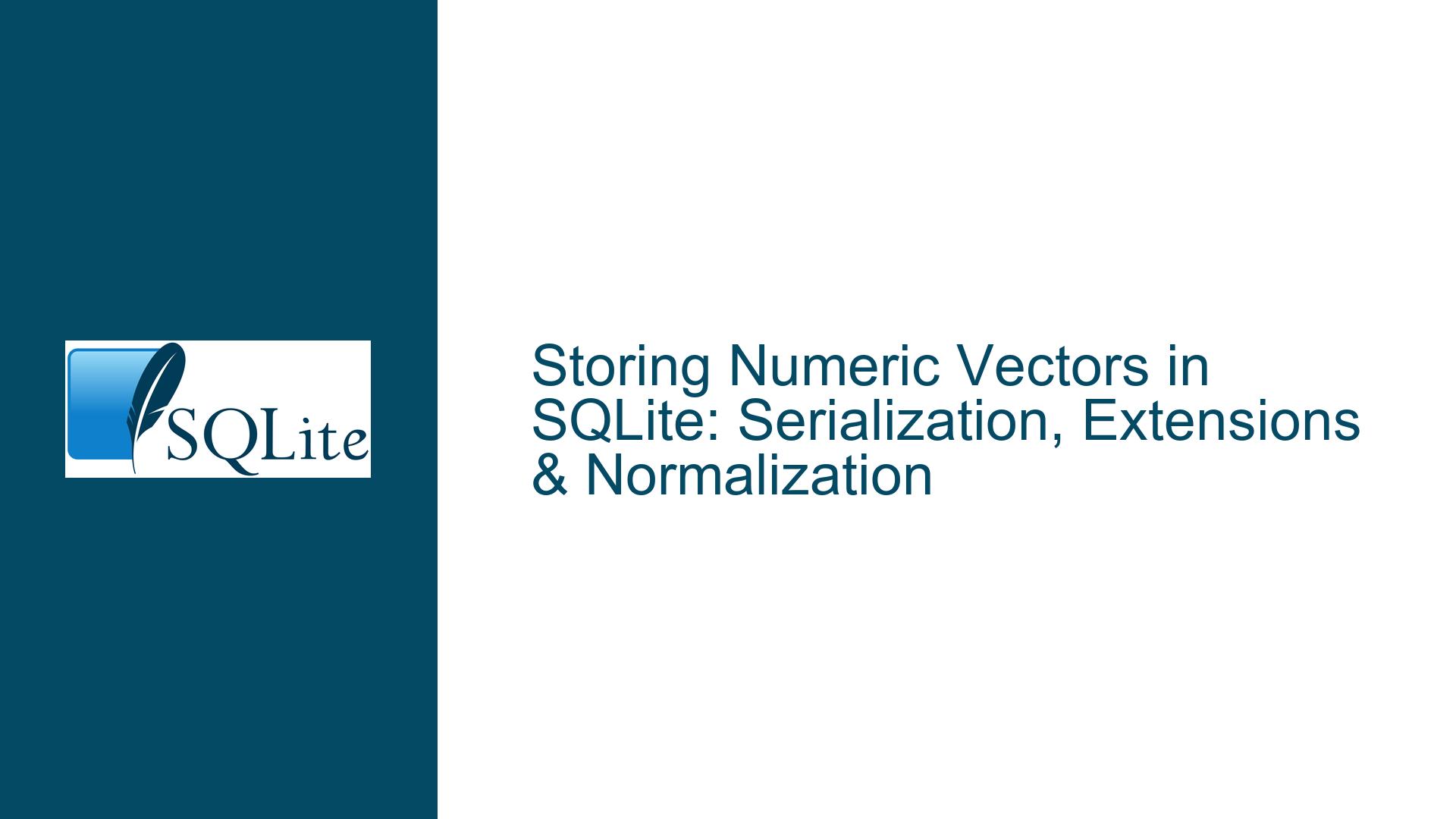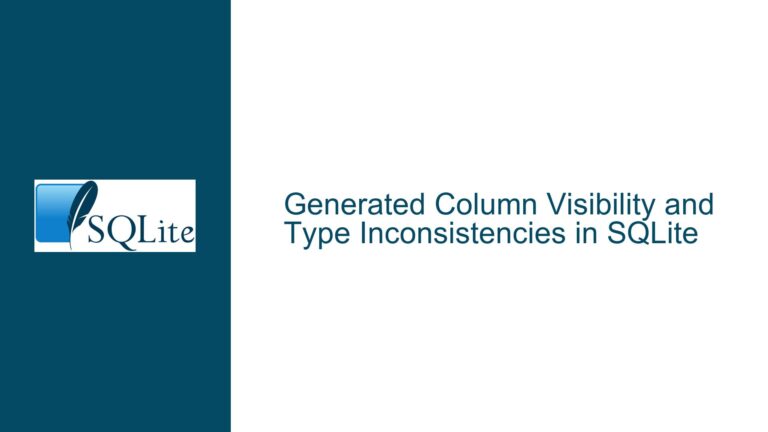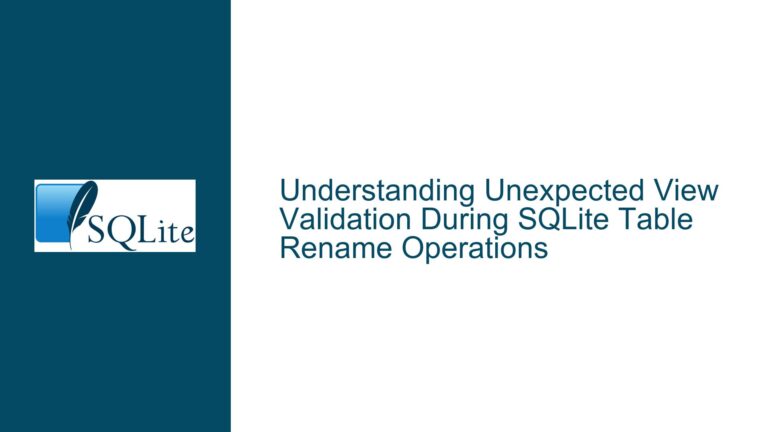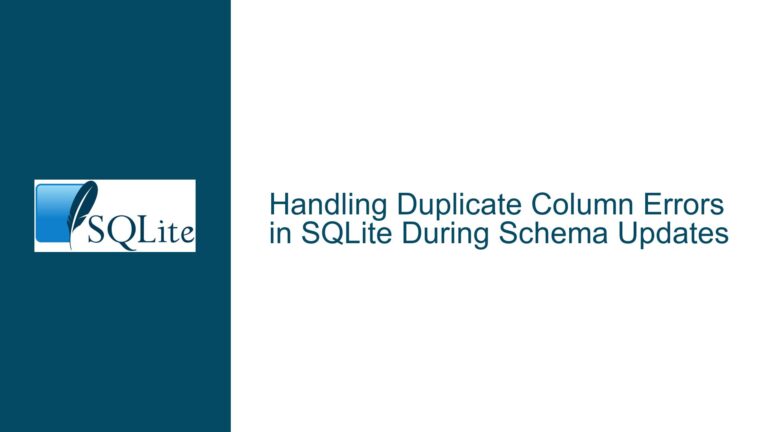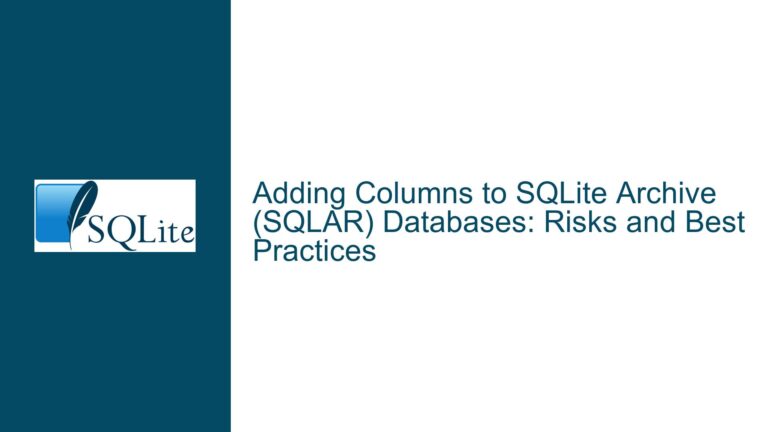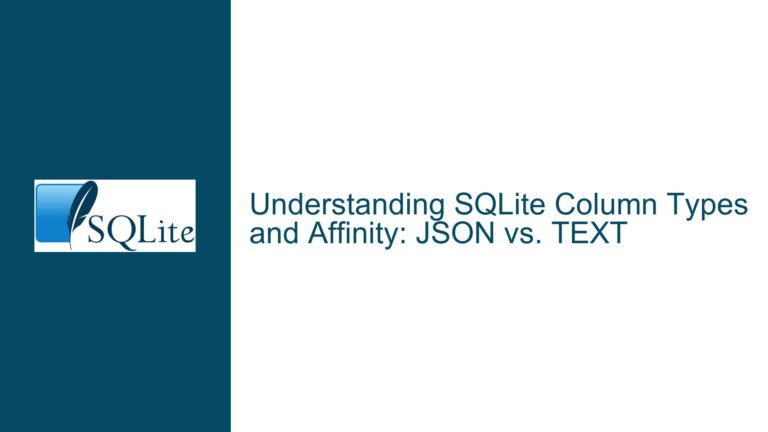Storing Numeric Vectors in SQLite: Serialization, Extensions & Normalization
Storing and Retrieving Multi-Dimensional Numeric Data in SQLite
1. Understanding SQLite’s Scalar Storage Model and Vector Serialization Requirements
SQLite is a relational database management system (RDBMS) designed around the principle of atomic scalar values. Each cell in a table—the intersection of a row and column—must contain a single value. This design inherently conflicts with the concept of storing multi-dimensional numeric vectors (e.g., [1.1, 3.5, 8.5]) directly in a single column. However, practical workarounds exist to serialize, store, and reconstruct vectors while adhering to SQLite’s constraints.
Key Challenges
- Scalar Enforcement: SQLite rejects attempts to insert non-scalar values (arrays, lists, etc.) directly. A vector must be converted into a single scalar representation (e.g., text, binary blob, or structured string).
- Data Integrity: Serialization methods must preserve numeric precision (critical for scientific or financial data).
- Query Efficiency: Retrieving and processing vector elements without deserialization in SQL is impractical unless extensions or normalized schemas are used.
- Environment Constraints: The original discussion involves C# on Windows, introducing considerations like 32/64-bit compatibility, .NET serialization APIs, and third-party extension dependencies.
Why Standard Formats Like JSON or TEXT Are Insufficient
- Overhead: JSON parsing/stringification adds computational costs, especially for large vectors.
- Precision Loss: Text-based formats may truncate floating-point numbers (e.g.,
1.1000000000000001becoming1.1). - Schema Rigidity: JSON requires additional validation to ensure vector structure consistency.
2. Root Causes of Vector Storage Limitations and Serialization Risks
Cause 1: SQLite’s Relational Model
SQLite enforces first normal form (1NF), which mandates atomic column values. This prevents direct storage of multi-value structures like vectors. Workarounds involve:
- Serialization: Convert the vector to a single scalar (BLOB, Base64 text).
- Normalization: Split the vector into rows or columns (e.g., a child table with one row per vector element).
Cause 2: Binary Serialization Security in C#
The user raised concerns about BinaryFormatter, Microsoft’s legacy API for binary serialization. Key risks include:
- Insecure Deserialization: Malicious payloads can execute arbitrary code during deserialization (CVE-2020-1147).
- Deprecation:
BinaryFormatteris obsolete in .NET 5+ and unsupported in .NET Core. Modern alternatives likeDataContractSerializerorSystem.Text.Jsonare safer but require schema compatibility.
Cause 3: Extension Compatibility Issues
The sqlean array extension provides native array support but introduces challenges:
- Compilation Complexity: Users must compile from source for 32-bit Windows, which involves resolving dependencies (e.g., missing
arrayagg_initsymbols). - Runtime Errors: Incorrectly compiled extensions fail to load (e.g., “The specified module could not be found” due to architecture mismatches).
Cause 4: Misalignment with Normalization Best Practices
Storing vector elements in separate rows or columns aligns with relational principles but complicates application logic:
- Insert/Delete Overhead: Modifying a vector requires multiple row operations.
- Query Complexity: Aggregating vector elements across rows/columns is verbose.
- Schema Changes: Adding columns for new vector dimensions requires
ALTER TABLE.
3. Solutions for Storing Vectors: Serialization, Extensions, and Schema Design
Solution 1: Binary Serialization with Safe .NET APIs
Step 1: Choose a Secure Serializer
Replace BinaryFormatter with:
DataContractSerializer: Requires defining[DataContract]and[DataMember]attributes.[DataContract] public class VectorData { [DataMember] public double[] Values { get; set; } } // Serialize var serializer = new DataContractSerializer(typeof(VectorData)); using var stream = new MemoryStream(); serializer.WriteObject(stream, new VectorData { Values = new[] { 1.1, 3.5, 8.5 } }); byte[] blob = stream.ToArray(); // Store in SQLite command.Parameters.AddWithValue("@blob", blob);System.Text.Json: Lightweight and cross-platform.string json = JsonSerializer.Serialize(new[] { 1.1, 3.5, 8.5 }); command.Parameters.AddWithValue("@json", json);
Step 2: Store as BLOB or Base64
- BLOB Column: Directly store the serialized byte array.
CREATE TABLE vectors (id INTEGER PRIMARY KEY, data BLOB); - Base64 Text: Encode the byte array for text storage.
string base64 = Convert.ToBase64String(blob); command.Parameters.AddWithValue("@base64", base64);Use SQLite’s
base64()function to decode:SELECT id, base64(data) FROM vectors; -- Encodes BLOB to Base64 text SELECT CAST(base64_decode(json) AS BLOB) FROM vectors; -- Decodes text to BLOB
Step 3: Optimize Performance
- Benchmark Serializers:
MessagePack(binary) vs.System.Text.Json(text). - Compression: Apply GZip compression to large vectors before serialization.
Solution 2: Using the sqlean Array Extension
Step 1: Compile the Extension for 32-bit Windows
- Clone the sqlean incubator branch.
- Use MSVC to compile
array.c:cl.exe /LD array.c /link /DLL /OUT:array.dll - Resolve linker errors by including dependent source files (e.g.,
arrayagg_init.c).
Step 2: Load the Extension in SQLite
.load 'D:\path\to\array.dll'
SELECT array('[1.1, 3.5, 8.5]'); -- Returns a parsed array BLOB
Step 3: Query Array Elements
Use extension functions like array_length() and array_get():
SELECT array_get(data, 0) AS first_element FROM vectors;
Limitations
- Platform Dependency: Precompiled binaries are 64-bit only.
- API Stability: The incubator extension is experimental and may change.
Solution 3: Normalized Schema Design
Option A: Child Table with Element Rows
CREATE TABLE vectors (
id INTEGER PRIMARY KEY,
-- Other metadata
);
CREATE TABLE vector_elements (
vector_id INTEGER,
index INTEGER,
value REAL,
PRIMARY KEY (vector_id, index),
FOREIGN KEY (vector_id) REFERENCES vectors(id)
);
Pros:
- Enables per-element queries (e.g., “Find vectors containing values > 5”).
- Avoids serialization overhead.
Cons:
- Inserts require multiple statements.
- Retrieving full vectors needs
GROUP_CONCATor application-side aggregation.
Option B: Wide Table with Fixed Columns
CREATE TABLE vectors (
id INTEGER PRIMARY KEY,
value0 REAL,
value1 REAL,
value2 REAL,
-- ... up to max expected size
);
Pros:
- Single-row retrieval.
- Columnar storage optimizations.
Cons:
- Schema changes required for larger vectors.
- Sparse columns waste space if vectors vary in size.
Solution 4: Hybrid Approach (JSON + Virtual Columns)
Use SQLite’s JSON1 extension to store vectors as JSON arrays and create virtual columns for indexing:
CREATE TABLE vectors (
id INTEGER PRIMARY KEY,
data TEXT, -- JSON array
-- Generated columns for first 3 elements
value0 REAL GENERATED ALWAYS AS (json_extract(data, '$[0]')),
value1 REAL GENERATED ALWAYS AS (json_extract(data, '$[1]')),
value2 REAL GENERATED ALWAYS AS (json_extract(data, '$[2]'))
);
Pros:
- Balances flexibility with queryability.
- Avoids deserialization in queries for indexed elements.
Cons:
- JSON parsing overhead.
- Requires SQLite 3.31+ (generated columns).
Decision Guide: Choosing the Right Approach
| Scenario | Recommended Solution |
|---|---|
| High-performance, large vectors | BLOB with MessagePack serialization |
| Query individual elements frequently | Normalized child table |
| Mixed environments (C#/Python) | Base64-encoded JSON |
| Experimental/advanced use cases | sqlean array extension |
| Avoiding schema changes | JSON with virtual columns |
Final Recommendations
- Prioritize Security: Use
DataContractSerializerorSystem.Text.Jsoninstead ofBinaryFormatter. - Benchmark Serialization: Test protobuf, MessagePack, and JSON for speed/size trade-offs.
- Prefer Normalization for Query Flexibility: If vectors require SQL-level analysis.
- Consider Extensions Cautiously: Compile sqlean from source and test thoroughly.
By aligning storage strategies with application requirements and SQLite’s constraints, developers can efficiently manage numeric vectors while mitigating security and performance risks.
